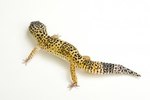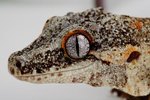
Veiled chameleons (Chamaeleo calyptratus) are striking and sizable reptiles originally from the Middle East -- specifically Yemen and Saudi Arabia. Although these sturdy diurnal lizards are found all over their natural haunting grounds, they are beloved and relatively common household pets elsewhere on the Earth, too. Veiled chameleon care is specific to the species, so don't assume all types of chameleons have the same requirements.
Living Spaces
Enclosures that are constructed out of both wire and wood can make suitable living environments for pet veiled chameleons. For a fully mature veiled chameleon, opt for a cage that is a minimum of 2 feet in width and length. As far as height goes, make sure that it is no shorter than 3 feet. Screened units help to encourage sufficient air circulation.
Food
If you plan on having a veiled chameleon in your life, you need to have the proper food. These omnivores are big on bugs -- think cockroaches, locusts, grasshoppers, fruit flies, waxworms, mealworms and crickets. Insects serve as strong foundations for their menus. Veggies are beneficial for these chameleons -- think ficus leaves, kale, mustard and collard greens. Gut-load bugs before offering them to your critter. Gut-loading entails feeding the prey nutritional items before they make their way into your pet's body. Dry feline food, carrots and zucchini all work well for gut-loading. In putting together your veiled chameleon's diet, seek the guidance of a trusted exotic veterinarian. Do not feed your chameleon -- or his prey -- anything unless you are fully certain of the food's safety and nutritional benefits.
Water
Still water and a veiled chameleon do not go together. However, the little guy does need to take in water. Instead of offering your pet water for drinking, conduct a light spraying of his living environment regularly and allow him to take the important stuff in that way.
Heat and Lights
As far as living space goes, roomy enclosures aren't the only things that count. The things inside of them also matter greatly. Since the veiled chameleon is a cold-blooded reptile, he lacks the ability to generate body heat by himself. Because of this, basking is crucial for his well-being. Ensure that your chameleon has places to bask by placing numerous branches in his environment. For heat, basking lights work well as long as they are securely and properly seated out of the enclosure. Burns are a severe hazard; outside placement of the lamps limits risk of them occurring. Ultraviolet lights are also necessary for the veiled chameleon.
Arboreal Setting
Veiled chameleons are tree-dwelling animals, and it is important to give their living environments a cozy appearance that is similar to what comes naturally to them. Apart from branches, plants such as ficus trees and hibiscus are useful elements. Vine plants are a must for helping veiled chameleons get from point A to B. Make sure that all plants you choose are 100 percent harmless to these lizards, as they frequently nibble on them. Speak to a veterinarian to ensure that the plants you select are indeed safe for veiled chameleons. If you place newspaper on the floor of the cage, it can help collect waste and greatly speed up the cleaning process.
References
- Florida Fish and Wildlife Conservation Commission: Veiled Chameleon
- University of Michigan Animal Diversity Web: Chamaeleo calyptratus
- Smithsonian National Zoological Park: Veiled Chameleon
- ReptileChannel.com: Veiled Chameleon Reptiles
- ReptileChannel.com: Veiled Chameleon Care
- ReptileChannel.com: Handling Chameleons
- ReptileChannel.com: Chameleon Health Tips
Photo Credits
-
Tom Brakefield/Stockbyte/Getty Images



